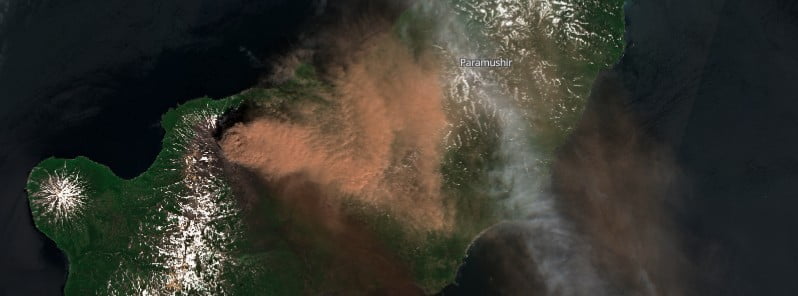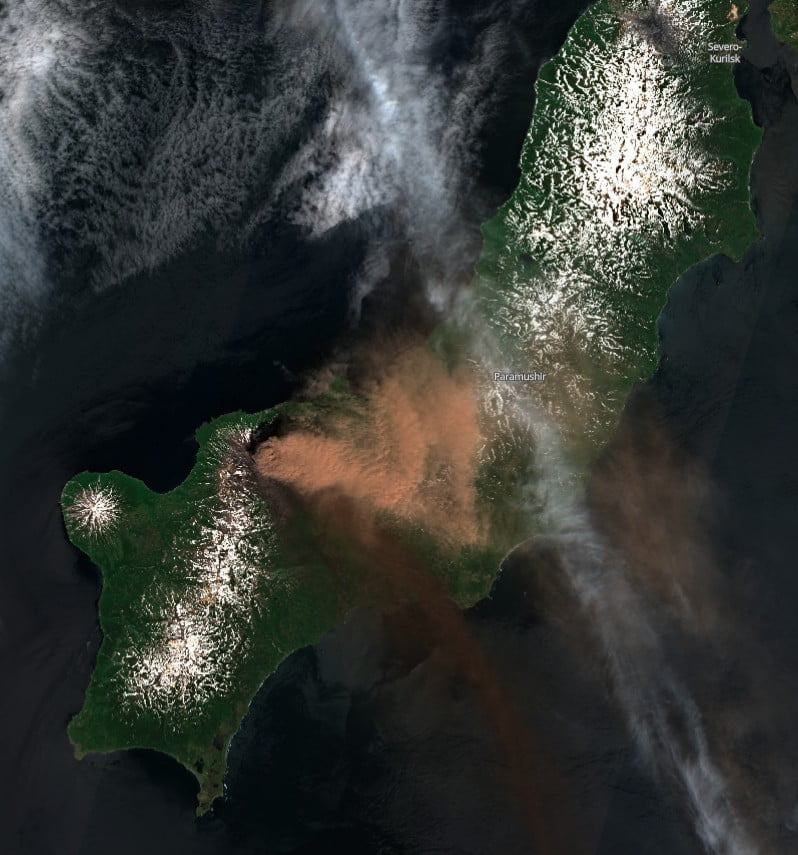Eruption at Chikurachki volcano, Aviation Color Code raised to Orange, Russia

A new eruption started at Chikurachki volcano, northern Kuriles, Russia at around 20:00 UTC on June 23, 2022, forcing KVERT to raise the Aviation Color Code from Green to Orange.
Satellite data by KVERT showed a big ash cloud 14 x 30 km (8.7 x 18.6 miles) in size moving 25 km (15 miles) to the SE of the volcano at 20:50 UTC.1
Ash cloud was rising up to 4.5 km (15 000 feet) above sea level at 23:20 UTC.
KVERT warns that explosions up to 6 km (19 700 feet) above sea level could occur at any time, affecting low-lying aircraft.
Ash emissions continued into June 24 when the Sentinel-2 satellite captured this image of the eruption:

KVERT reported that the eruption at Chikurachki that began on January 31, 2022, was over by February 2. Explosions generated ash plumes that rose as high as 5 km (16 400 ft) a.s.l. and drifted as far as 255 km (158 miles) W, SW, S, and SE.2
The Aviation Color Code was lowered to Yellow on February 3 and to Green on February 5, the lowest color on a four-color scale.
Geological summary
Chikurachki, the highest volcano on Paramushir Island in the northern Kuriles, is actually a relatively small cone constructed on a high Pleistocene volcanic edifice. Oxidized basaltic-to-andesitic scoria deposits covering the upper part of the young cone give it a distinctive red color.
Frequent basaltic plinian eruptions have occurred during the Holocene.
Lava flows from 1 781 m (5 843 feet) high Chikurachki reached the sea and form capes on the NW coast; several young lava flows also emerge from beneath the scoria blanket on the eastern flank.
The Tatarinov group of six volcanic centers is located immediately to the south of Chikurachki, and the Lomonosov cinder cone group, the source of an early Holocene lava flow that reached the saddle between it and Fuss Peak to the west, lies at the southern end of the N-S-trending Chikurachki-Tatarinov complex.
In contrast to the frequently active Chikurachki, the Tatarinov volcanoes are extensively modified by erosion and have a more complex structure.
Tephrochronology gives evidence of only one eruption in historical time from Tatarinov, although its southern cone contains a sulfur-encrusted crater with fumaroles that were active along the margin of a crater lake until 1959.3
References:
1 VONA/KVERT Information Release, June 23, 2022. KVERT, Institute of Volcanology and Seismology FEB RAS
2 Global Volcanism Program, 2022. Report on Chikurachki (Russia). In: Sennert, S K (ed.), Weekly Volcanic Activity Report, 2 February-8 February 2022. Smithsonian Institution and US Geological Survey
3 Chikurachki – Geological summary – GVP
Featured image: Eruption at Chikurachki volcano on June 24, 2022. Credit: Copernicus EU/Sentinel-2, EO Browser, The Watchers

Commenting rules and guidelines
We value the thoughts and opinions of our readers and welcome healthy discussions on our website. In order to maintain a respectful and positive community, we ask that all commenters follow these rules.